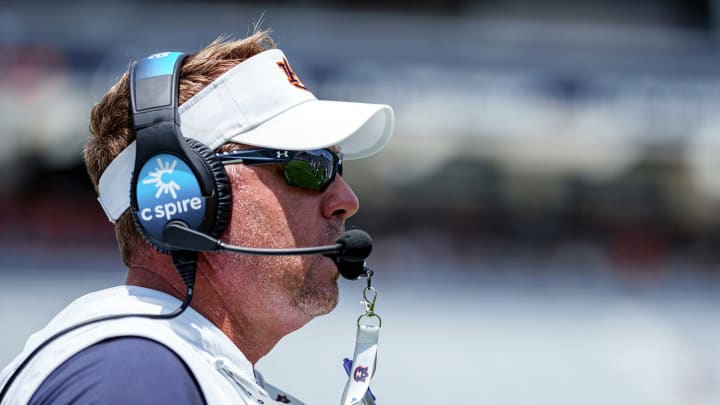Hugh Freeze goes Old School as He Masters New Communication System

Earlier this offseason, Auburn Tigers head coach Hugh Freeze sounded a little lukewarm about embracing new NCAA helmet-to-helmet communications this coming season.
Truth is, you fail to embrace the new technology at your peril, because other teams will work the system in order to improve the method of communicating with their quarterbacks and leave you in their vapor trail.
Freeze might have sounded a little more John Madden than Sean McKay at times, but he absolutely can't afford to let the grass grow under his feet.
Freeze has perhaps unsurprisingly approached the challenges of communicating differently by remaining rooted in some trusted old school methods. That doesn't necessarily mean he's a dinosaur - more doubling down in polishing up protections and developing his extremely-young group of wide receivers.
Above all else, the Tigers boss wants his guys to be solidly on the same page before putting something else on their plate.
"We've adjusted the protections really well this week, the receivers are steadily coming on Perry (Thompson), Malcolm (Simmons), Bryce (Cain), Cam (Coleman). Sam Jackson had his best practice yesterday, and Robert (Lewis) and Camden Brown really, really had a good day," Freeze said last week.
Freeze clearly has a theory that if everyone knows where they need to be in the first place - conveying the message in the huddle should be pretty peachy thereafter.
Prioritizing getting his precocious pass catching group on the same page with their experienced signal caller Payton Thorne makes a lot of sense in that regard - accumulating reps is the real rub.
Beyond what they have already learned and scripted out in the meeting rooms, it's how Freeze will get his head around when to talk into his Thorne's helmet, or let him work things out himself, which will prove most crucial.
"So I think the more they work together, the more (Payton) understands my expectations on when to kill the play, get out of one that's not good," Freeze explained. "The more he can do that for us, the better off we are. I can help with that until 15 seconds, but things change sometimes.
"I think everybody's trying to maneuver around that. Do we hold it until 15 seconds some so that the defense can't (adjust) then you put it all on Payton? Or do we try to start with 30 seconds talking to him and knowing that they still can change with 15? So we're all dealing with that, but it's been a really impressive week for his understanding."
In general terms, all programs and their coaching staffs will be working things out just like Freeze and Co. At least in Thorne, Freeze has a signal caller with plenty of experience dealing with embracing and absorbing new ways of working, but if they can get themselves completely on point, it can also let their guy really thrive.
All of which should give Auburn a real edge, but coaches who have some previous NFL experience will have an early advantage having worked with helmet-to-helmet communication at the pro level.
We can assume that everyone will find their own groove come time, and real game action is really the only place where things will find some kind of new equilibrium.
In the meantime, foundations are being built the old fashioned way by Freeze and the additional frills will get added incrementally as they go, especially if Thorne continues to prove receptive.
